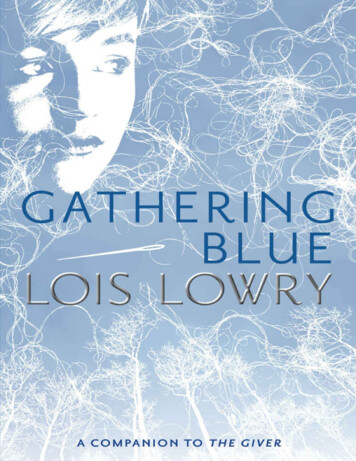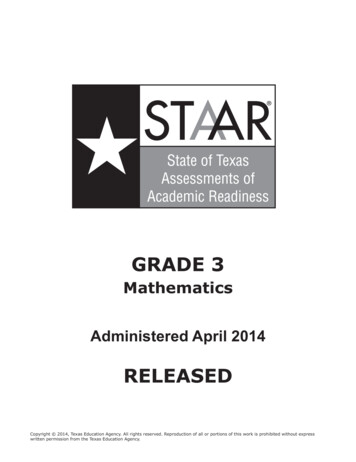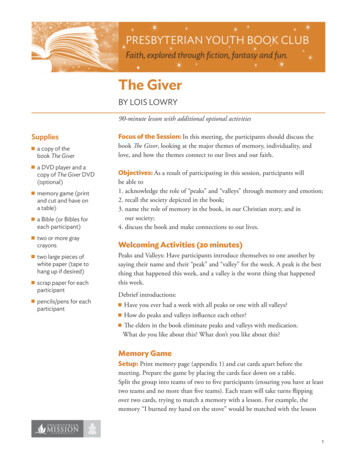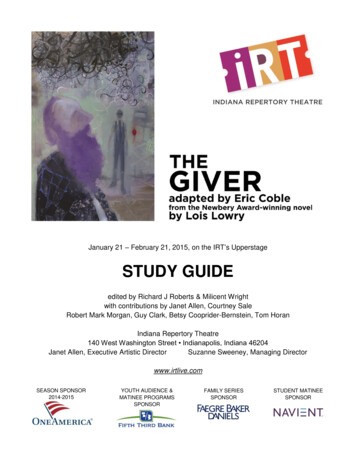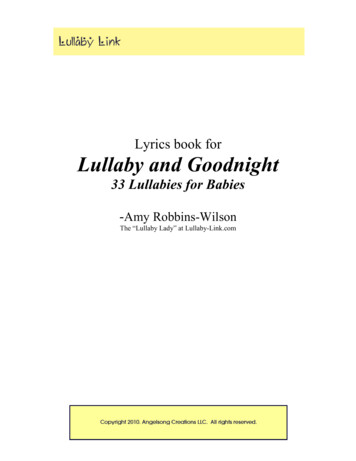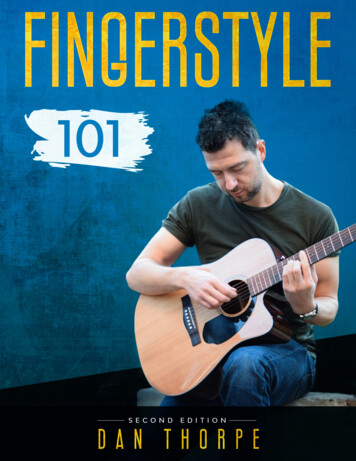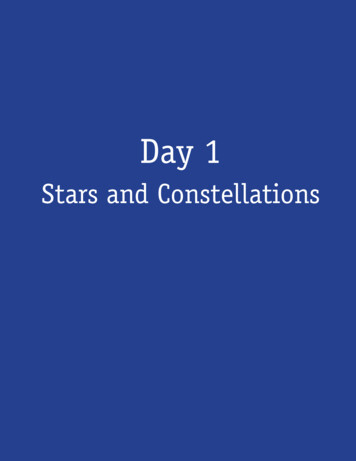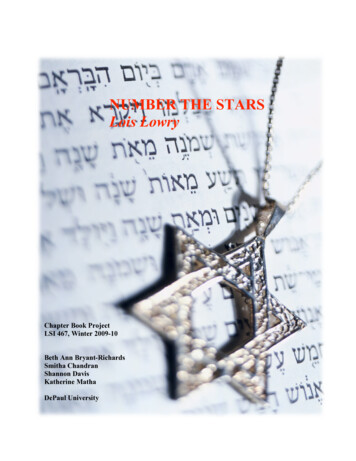
Transcription
NUMBER THE STARSLois LowryChapter Book ProjectLSI 467, Winter 2009-10Beth Ann Bryant-RichardsSmitha ChandranShannon DavisKatherine MathaDePaul University
Contents1.Synopsis.1Themes .12.Flesch-Kinkaid Readability Statistic.2Chapters 1 and 2 - Shannon Davis.2Chapters 3 and 4 – Katherine Matha.2Chapters 12 and 13 – Beth Ann Bryant-Richards.2Chapters 15 and 16 – Smitha Chandran.23.Author Study.44.Lesson Plan #1 – Advanced Word Reading .5Chapters 1 and 2 – Shannon Davis .5Chapters 3 and 4 – Katherine Matha.7Chapters 12 and 13 – Beth Ann Bryant-Richards.9Chapters 15 and 16 – Smitha Chandran.125.Lesson Plan #2 – Direct Fluency Instruction.14Chapters 1 and 2 – Shannon Davis .14Chapters 3 and 4 – Katherine Matha.15Chapters 12 and 13 – Beth Ann Bryant-Richards.16Chapters 15 and 16 – Smitha Chandran.176.Vocabulary Instruction .18Chapters 1 and 2 – Shannon Davis .18Chapters 3 and 4 – Katherine Matha.21Chapters 12 and 13 – Beth Ann Bryant-Richards.23Chapters 15 and 16 – Smitha Chandran.267.Direct Comprehension Instruction .30Chapter 1 – Shannon Davis .30
Chapters 3 and 4 – Katherine Matha.32Chapters 13 and 14 – Beth Ann Bryant-Richards.33Chapters 15 and 16 – Smitha Chandran.358.Extension Activities .40
Number the Stars1. SynopsisNumber the Stars by Lois Lowry tells the story of ten-year-old Annemarie Johansen and herbest friend Ellen Rosen during the Nazi occupation of Denmark in 1943. The Rosens and theJohansens live in Copenhagen, and we learn early in the book about Annemarie’s deceased oldersister, Lise, who had been engaged to marry Peter when she was tragically killed. When wordreaches the Rosens that the Nazis will begin detaining Jews, the Rosens go into hiding with thehelp of Annemarie’s parents and members of the Danish Resistance. Annemarie, her little sisterKirsti, and Mrs. Johansen travel to the coast of Denmark to help the Rosens and other Jewsescape to Sweden via the Baltic Sea. Annemarie’s Uncle Henrik, a Dutch fisherman, aides in thisdramatic escape, as does Peter from the Resistance movement.The brilliant and multilayered title chosen by Lowry refers to the Star of David necklace thatEllen wears, a reference to Jewish traditions and culture. “Number the stars” is also a phraserepeated from the Bible in a psalm recited during a critical time in the narrative:O praise the Lord.How good it is to sing psalms to our God!How pleasant to praise him!The Lord is rebuilding Jerusalem;he gathers in the scattered sons of Israel.It is he who heals the broken in spiritand binds up their wounds,he who numbers the stars one by one Also, Lowry frequently references the number of stars in the sky or the starless night sky.Number the Stars brings to mind the six million Jews murdered over the course of the Holocaust.Themes Holocaust Coming of Age Loss of Innocenceo through Deatho due to War Sacrifice and Responsibility1
Number the Stars2. Flesch Kinkaid Readability StatisticChapters 1 and 2 Shannon DavisBeginning of the chapter 1, pg 1 Flesch-Kincaid 4.7*Middle of the chapter 1, pg 5-6 Flesch-Kincaid 9.7End of the chapter 2, pg 9-10 Flesch-Kincaid 3.7Flesch-Kincaid average 6.03*This readability statistic is higher than the others because the passage included expositoryprose. The other two selections contained more dialogue.Chapters 3 and 4 – Katherine MathaBeginning of the chapter 3, pg 19 Flesch-Kincaid 5.4Beginning of chapter 4, pg 27 Flesch-Kincaid 7.4End of chapter 4, pg 37 Flesch-Kincaid 2.8Flesch-Kincaid average 5.23Chapters 12 and 13 – Beth Ann Bryant RichardsBeginning of the chapter 13, pg 101 Flesch-Kincaid 3.6End of the chapter 13, pg 98 Flesch-Kincaid 4.7Middle of the chapter 14, pg 109 Flesch-Kincaid 5.8Flesch-Kincaid average 4.7Chapters 15 and 16 – Smitha ChandranBeginning of the chapter 15, pg 113 Flesch-Kincaid 5.52
Number the StarsMiddle of the chapter 15, pg 116 Flesch-Kincaid 2.9End of the chapter 15, pg 119 Flesch-Kincaid 4.2Flesch-Kincaid average 4.1ReadabilityChapterChapters 1 and 2Chapters 3 and 4Chapters 12 and 13Chapters 15 and 16Readability6.035.234.74.1Any discrepancy is due to heavy dialogue in some passages, while other passages containedexpository prose.3
Number the Stars3. Author StudyLois LowryBorn in 1937, Lois Lowry professed a love of reading and writing since her childhood,which was spent traveling the world. Her father was an Army dentist, and she says she still lovesto travel. Lowry married young, had four children, and did not begin writing until her mid-30s.She currently lives in Boston and Maine, and makes time to enjoy her grandchildren and herdogs. A prolific writer, she has won numerous awards, including two Newbery medals. Checkout her blog: http://loislowry.typepad.com.Lowry’s older sister died when they were children, and early death has been a motifthroughout her writing career. Lowry also suffered the loss of her son, an Air Force pilot killedin a crash. Lois Lowry writes that her books all deal with essentially the same theme:recognizing the interconnectedness of the human experience. Her books are popular with adultsand children alike. Her popular titles include the Anastasia series, Number the Stars; The Giver,Messenger, and Gathering Blue (a trilogy); and Autumn Street.4
Number the Stars4. Lesson Plan #1 – Advanced Word ReadingChapters 1 and 2 – Shannon DavisWord List #1Word List #2Word List #3Affixes/ed/ endings1.2.3.4.5.6.7.8.1.2.3.4.5.6.7./ai/ /vCv/ vowelcombinations1. wait2. wailed3. trailed4. tail5. glare6. face7. pale8. dcivilizedhesitatedScript for Word List #2Instructions:Teacher1. Today we are going to be learning about the -edending. There are three rules to the correctpronunciation of the -ed ending.Student Response2. The first rule is, if a word ends with a letter t ord, the -ed is pronounced /ed/ . What sound doesit make when it follows the letter t or do? Yes./ed//ed/3. Next rule. If a word ends in a voiceless sound,then the /ed/ is pronounced at a /t/. What sounddoes the -ed ending make when the end sound isvoiceless? Yes. /t//t/4. Last rule. When the last sound of a word is avoiced sound, the -ed ending sounds like a /d/.What is the sound of the -ed ending when itfollows a voiced sound? Yes. /d//d/5. Next, we are going to practice the rules we justlearned. Let us look at the word, adjusted. Whatletter comes before the -ed ending? Yes, t.Which rule will we follow, the first, second, orthird? If a word ends with a t or d, the rule says/ed/, adjusted /ed/5
Number the Starswe pronounce the -ed ending as an /ed/. Whatsound? Yes. /ed/. So how would we say thisword? Yes. Adjusted /ed/.6. We are now going to look at the word walked.Think about what rule we will follow in order tocorrectly pronounce the -ed ending. Is the endsound voiced or unvoiced? Yes. Unvoiced. Whatwould the -ed sound like in this word? Yes. /t/.So how would we say this word? Yes. Walked/t/.unvoiced, /t/, walked /t/7. Lastly, we will look at the word civilized. Whatrule will this word follow? What sound comesbefore the -ed ending, is it voiced or unvoiced?How would we correctly pronounce this -edending? Yes. /d/. If the -ed sounds like a /d/ atthe end, how would we pronounce this wordcorrectly? Yes. Civilized. /d//d/ civilized /d/Error Correction:1. If an error occurs I will use the My Turn - Your Turn pattern.2. If the error is still occurring, I will re-explain the rules and see if the student can figure itout. If student is still having trouble, I will allow him/her to call on a friend for help andthen have the student repeat it. I will then call on that student at a later period during thelesson or address his/her needs individually.Adaptations:1. I will have students get out a blank piece of paper and pencil. I will call out words endingin -ed and have them write down which way it is being pronounce; /ed/, /t/, /d/.2. Students will be given a worksheet where there is a word written down with an -edending. Next to each word will be three responses; /ed/, /t/, or /d/. Students must circlewhich response is the correct one.Extensions:1. Students will go through a chapter and highlight all the words that end in -ed. They willthen write down each word and the correct pronunciation of the -ed ending next to it.2. Students will look at music lyrics that I have available for them. They will highlight thewords that end in -ed. They will need to figure out the correct -ed pronunciations becausethey will tape themselves reading the lyrics. I will listen to the recording and they willalso to see if they are pronouncing the words correctly.6
Number the StarsChapters 3 and 4 – Katherine MathaWord List eturnWord List #2/ed/ endingsPassedRelaxedOpenedPoutedWalkedManagedWord List #3/ea/ vowel rsScript for Word List #2Instruction:Teacher1. Today we are going to learn three rules about thepronunciation of the letters –ed at the end of words.The first rule is that if a word ends in a t or a d, the ed is pronounced /ed/. What sound does the ed makewhen it follows a t or a d? (teacher signals for aresponse and students give it). Yes!Students/ed/2. The second rule is that if a word ends in a voicelesssound, the -ed is pronounced /t/. What sound does the-ed make when it follows a voiceless sound?(teachersignals for a response and students give it). Yes!/t/3. You are doing great! The final -ed rule is that if aword ends in a voice sound, the -ed is pronounced/d/. What sound does the -ed make when it follows avoice sound? (teacher signals for a response andstudents give it). Yes! /d//d/4. Great! Now let’s apply these rules to some of thevocabulary words. Let’s look at the first word,pouted. What letter comes before the -ed? (teachersignals for a response and students give it). Good, t!So which rule do we follow? If a word ends in a t or ad, the -ed is pronounced /ed/./t/5. Let us now look at the word walked. What is the lastletter before the -ed? Good, K. Is that a voiced letter?No, good. So let’s practice pronouncing thataccording to its rule /t/. Walked /t/. You are all doinggreat!/k/NoWalked /t/7
Number the Stars6. Let’s look at the word managed. What is the lastletter before -,ed? (Students are signaled to answer).G, good! Let’s all practice saying managed accordingto the rule /d/. Managed /d/./g/Managed /d/Error Correction:If an error occurs, I will use the My Turn, Your Turn Pattern. If this is not successful, I will reexplain the rules and we will practice with a larger list of words.Adaptation:1. I will give students a list with 5-10 more words. I will have them write next to the word ifit is a /t/, /d/, or an /ed/ rule.2. I will have students write down 3 voiced letters and 3 unvoiced letters and give anexample of words that have these sounds.Extension:Students will be given a short story relating to the book that we are reading such as a shorthistory of the war. They will circle –ed words. I will ask that they find 2 words that fall undereach category.8
Number the StarsChapters 12 and 13 – Beth Ann Bryant RichardsWord List visiblediscoloredWord List #2/ee/ vowelcombinations/ea/ vowelcombinations1. sleep2. breeze3. trees4. dreams5. lean6. cream7. reach8. gleamWord List #3/ed/ /t/ /d/endings1.2.3.4.5.6.7.tripped /t/wiped /t/grasped /t/hurried /d/blurred /d/pulled /d/faltered/ed/Script for Word List #2Instructions:Teacher1. There are two spellings for the long e sound.The first one we will work with is spelled “ee”as in “seek.”Student Response2. My Turn. Point to the “ee” with finger to the leftof the letter. “My turn. Here’s our new soundfor today.” (loop signal)“/long e/” (loop backto starting point).3. Your Turn. (finger to the left of the letter)“Your turn. What sound?” (loop signal)(answer) (loop back to starting point) “Yes,/long e/.”/long e/4. Individual Student Checkout(finger to the left of letter) “Individual turns.What sound? Bobby.” (loop signal) (answer)(loop back to starting point) “Yes, /long e/.”/long e/5. Remember, there are two spellings for the long esound. The second one we will say is spelled“ea” as in “treat.”6. My Turn. Point to the “ea” with finger to the leftof the letter. “My turn. Here’s our new soundfor today.” (loop signal) “/long e/” (loop backto starting point).9
Number the Stars7. Your Turn. (finger to the left of the letter)“Your turn. What sound?” (loop signal)(answer) (loop back to starting point) “Yes,/long e/.”/long e/8. Individual Student Checkout(finger to the left of letter) “Individual turns.What sound? Bobby.”(loop signal) (answer) (loop back to startingpoint) “Yes, /long e/.”/long e/9. Your Turn to Read the RowStarting at the first letter combination, movethrough the row of letters in the words on thelist, signaling for each letter combination just asyou did in Steps 3 and 7. As you move throughthe list say, “What sound?” for each lettercombination./long e/10. Point to random letters. Starting at the first lettercombination, move across the row of letters onthe list, signaling for each letter combination asyou did in Step 9. As you point to random lettercombinations on the list say, “Individual turns.What sound? Timmy.”/long e/Error Correction:If an error occurs in Steps 3 or 7, immediately return to a My Turn-Your Turn Pattern.If an error occurs at Steps 4 or 8, immediately return to a My Turn-Your Turn Pattern. Thenalternate between the missed letter and familiar letters until students identify the missed lettercorrectly three times.Adaptations:1. If students continue to make errors after the Error Correction procedure outlined above,make a Podcast using Garage Band with your script for the letter combinations so thatthey may practice it on their own or at home. Include a sheet for students about how touse the scripted Podcast, along with a list of the words.2. If you anticipate difficulty with distinguishing both “ee” and “ea” as /long e/, or ifstudents continue to make errors after the Error Correction procedure outlined above,adapt the lesson to teach only “ee” vowel combinations as /long e/ and save the lesson on“ea” vowel combinations for later. Once students have mastered “ee” vowelcombinations, then move to “ea” vowel combination words.Extensions:1. For word list #1, explain that the prefixes in for each word change the meaning of thebase word. The prefixes are: un-, dis-, and in-. Remind students that a prefix comes at thebeginning of the base word. Ask students to make a list of as many words (or to tell you a10
Number the Starslist of words) using these prefixes as they can think of. Give them a homework pass or aprize for the longest list.2. For word list #2, ask students to identify words at school or home that contain the vowelcombinations “ee” and “ea.” They can find words in their science or social studiestextbooks, on a billboard, on the classroom word wall, or in a newspaper or magazine.Give them a homework pass or prize for the longest list.11
Number the StarsChapters 15 and 16 – Smitha ChandranWord List #1Irregular Words1. said2. laugh3. soldier4. relief5. through6. she7. there1.2.3.4.5.6.7.8.9.Word List #2Suffix pletelyabsolutelyquicklyWord List #3Vowel fe6.escape7.hate8.aside, inside9.hide10. chokeScript for Word List #3Instruction:Teacher1. Write a CVC word that can be converted into CVCeword, (e.g. hat) on the blackboard“What word?”Yes “hat. What’s the vowel?”“Yes a”. “What sound does “a” make in hat?”“Yes /ă/ as in h/ă/t”2. Add the letter ‘e’ to the word hat on the blackboard.Teach the students the rule of VCe – the magic ‘e’.“In the word hate the magic ‘e’ is silent and ‘e’becomes a helper and makes the vowel ‘a’ stronger.The vowel ‘a’ says its name now (makes the ‘a’ long).“What does the magic “e “do?”“Yes. Well done!”Student Response“hat”“a”“㔓The magic ‘e’ is silent andbecomes the helper .”3. Practice one syllable words from word list #34. Advanced OrganizerVCe can be combined with open and closed syllablesto form multi-syllable words. Teach students to readthese words using segmentation e.g. ab/sol/ute5. Individual Student CheckoutWrite the word ‘absolute’.“Can you find the the VCe in ‘absolute’?“Yes ‘ute’ ”.Write “ab/sol/ute”. Point to each segment and ask the“ute”“ab/sol/ute”“absolute”12
Number the Starsindividual student to read-Loopback to the first letter and ask the student to readthe whole word“Yes absolute”6. Practice the multi-syllable words in word list #3Error Correction:If an error occurs at any step, repeat steps 1 and 2. Practice more examples.Adaptations:1. Use color-coded letter tiles to make words. For example, red tiles for vowels and blue forconsonants and green for consonant blends.2. Make a list of most common VCe words (Word list is available at www.resourceroom.net) foreveryday practice.3. Highlight the VCe part of the words in the chapter and mark long and short vowels withsymbols. This serves as a visual cue.Extensions:1. Pair students and give them a page from the chapter book to read. They are to identify asmany VCe words as possible in a minute. Then each pair will read their words to the class.Errors will be corrected and practiced immediately.2. Watch a movie that shows adding the silent ‘e’ to the end of a word can change a short vowelinto a long one. www.brainpopjunior.com13
Number the Stars5. Lesson Plan #2 – Direct Fluency InstructionChapters 1 and 2 – Shannon DavisFluency Activities:1. Taped Readings – Give students text that they can accurately read at least 95% of thewords. I will give students the book and allow them to go over to the computer and beginrecording their readings. Once they are finished, they will need to listen to the tape andlist out the mistakes that they made. Ask students to repeat these steps several times, eachtime trying to get better. Once they are happy with their final product, they will turn it into me. This activity allows students to practice their fluency skills, work with technology,and self-monitor their own work.2. Haiku – Instruct students to write a haiku about Number the Stars. Assign studentspartners (one reader, one struggling reader) and create their own haiku. I will havealready taught students how to make up a haiku in 5-7-5 format. Once they havecompleted their haikus, students will practice reading it until they share their masterpiecewith the rest of the class. This activity focuses on fluency as well as syllables, writing,and comprehension.14
Number the StarsChapters 3 and 4 – Katherine MathaFluency Activities:1. Buddy Reading—Students will partner up with someone and sit side by side. Togetherthey can read the assigned chapter(s). They will encourage each other to ask questionsand to point out details. Buddy Reading can help when someone else reads with them.When they learn the sounds of the words better, they are able to figure out thepronunciation of the words. The better reader can help the struggling reader as they readtogether. The readers can take turns reading or read the words together. The strongerreader can help with the pronunciation, the meaning of words, and understanding thestory. They can ask questions as they read. The buddy can give clues when the otherstudent gets stuck on a word. When they are finished reading, they can ask each otherabout his or her favorite part or characters.Questions: What sound does the word start with? What word would make sense there? What problem does the character have? Who are the characters? How is the problem fixed? Tell me what is happening in the story so far.2. Secret Story Words -- Put names of people, places, things, and vocabulary words fromthe story on note cards and tape them to the student’s backs. Let them wander around theroom asking their classmates yes or no questions. When they’ve figured out what theirword is, they return to their seat and write down the significance of their word to thestory. When everyone is finished we can review the words or the teacher will check theirsentences for assessment. (I did this in junior high and remembered that I loved thisactivity.)3. Title Predictions -- To help students with comprehension, have them make predictionsabout what events might take place in the story based on the title of the chapter. Oncethey make predictions, the teacher gives a short summary of what the chapter is about andthe children write down some questions that they want answered when they read thechapter (this obviously is easier to do after the first few chapters after a plot has beenrealized). Have students give answers and write them on the chalkboard. I feel thatgiving the students a summary of what the chapter is about, especially the at-riskstudents, boosts their enthusiasm. They will less likely get bored and lose interest.15
Number the StarsChapters 12 and 13 – Beth Ann Bryant RichardsFluency Activities1. Newscaster—After reading the chapter, students will work in groups to write a newscastto recap the events of the chapter. They should work to summarize the plot from thechapter. Students can watch a few newscasts to find some newscasters to model. Theyshould take turns reading the newscast they have written together until they can read itexpressively and fluently. To take this activity further, groups could divide all thechapters in the chapter book and videotape their newscasts, putting each on a final DVD,demonstrating their commitment to quality.2. Word Wizards—Choose distinctive words from the chapter and write each in largeletters on 4” x 6” index cards. Have students work in pairs to take turns flipping the cardsso that their partner can read the words aloud. (Words: sped, coast, creep, morning,dreams, snuggle, sleep, stars, winced, meadow, kneeling, dashed, faltered.)3. Poetry Slam—Working with the words from the second activity above, students shouldeach write a poem using words that rhyme. Students will revise their poems and thenpractice reading them aloud with a focus on fluency, prosody, and inflection. Designate aday for a poetry slam in the classroom so that each student can show off his or herreading fluency.16
Number the StarsChapters 15 and 16 – Smitha ChandranFluency Activities:1. Bingo Word Game -- Choose high frequency words to make Bingo sheets. The teachercalls out each word and the student places the chip on the appropriate word. Other simplegames such as hangman can also help teach words.2. Different but the Same -- The teacher models reading the same sentence differentlydepending on the final punctuation. After modeling with exaggerated intonation, providean audiotape of the book for tape-assisted reading.3. Tape-assisted reading -- In tape-assisted reading, students read their books along with afluent reader on an audiotape. For the first reading, the student should follow the tape,pointing to each word in her or his book with the reader. Next, the student should try toread aloud along with the tape. Reading along with the tape should continue until thestudent can read the book independently without the support of the tape. Teachers canmake their own recordings of books so that they can select materials that are of highinterest to students and to control the pace of reading.17
Number the Stars6. Vocabulary InstructionChapters 1 and 2 – Shannon DavisVocabulary Instruction:Word List #1Indirect InstructionDefinition1. Civilized2. Pout3. ScurriedDirections4. Landscape5. SabotageWord List #2Direct Instruction ContextClues1.2.3.4.5.RucksackHalt (Halte)GiraffeRiflesProddedAdvanced Organizer:Today we are going to be learning some new words and what they mean. I am going to tell youthe definition and you will tell me the synonym.Script for Word List #1:TeacherStudent1. The first word is civilized. What word? Yes.Civilized. Civilized means to bring into anadvanced stage of social development.People act as if they have been educated andnot like monkeys. What does civilized mean?Yes. Can anyone tell me a synonym for theword civilized? Yes. Educated andhumanlike.Civilized means to move into advancedstages of social development. To actlike humans not animals. A synonymfor civilized is educated andhumanlike.2. Next word. The next word is pout. Whatword? Yes, pout. Does anyone know whatpout means? Yes. Pout means to showdispleasure by pushing out the lips. Whatdoes pout mean? Can anyone show me avisual representation of what pouting lookslike? Yes. What is a synonym for pout? Yes.Frown.Pout. Pout means to show displeasureby pushing out the lips. Frown.3. This same process will be repeated for therest of the word list: scurried, landscape, andsabotage.18
Number the StarsError Correction:If students are struggling with the definitions I am giving them, I will keep re-explaining thewords meaning until students understand it. If I can show them a visual representation of theword then I will model it for students. I will use the My Turn - Your Turn method to assiststudents until they have a clear understanding.Script for Word List #2:TeacherStudent1. Today we are going to be learning some newvocabulary words that you will encounter during yourreading. You will be given words that you must usethe context clues around or the dictionary to find themeaning. My suggestion would be to use the bookfirst by finding the word and then reading the passagearound it to use the context clues. Then move ontothe dictionary to find the word and then get thedefinition. If a word has multiple meanings in thedictionary, use the context clues from the story tofigure out the appropriate definition. Here is the listof words; rucksack, halt, giraffe, rifles, and prodded.What are the words you will be looking up? Yes.Rucksack, halt, giraffe, rifles, and prodded. All of thewords are located in the first chapter of your book. Itis necessary that you learn the meaning of thesewords before you begin reading, so you cancomprehend better.rucksack, halt, giraffe, rifles,and prodded2. I will do the first word with you to show you what Iexpect. The first word is rucksack. What word? Yes.Rucksack. Rucksack is located on the first page of thebook. Can anyone find it on the page? Yes. 4thparagraph 2nd line. Can someone read the sentence?Yes. What do you think rucksack means after readingthe context clues? Yes. Rucksack can mean abackpack. Let’s go to the dictionary to look up themeaning to make sure we are correct. Where will webegin? Yes. In the R section. Everyone, let’s find theword rucksack in the dictionary. What is thedefinition in the dictionary? Yes. A type of knapsackthat is carried by hikers. What is the definition class?Yes. Now you will go on to finish the word list byyourselves. Follow the steps that we just wentthrough for the word rucksack. If you have anyquestions please raise your hand and I will comeassist you. Good luck.Rucksack, 4th paragraph 2ndline, a backpack, Rucksack, atype of knapsack that is carriedby hikers19
Number the StarsError Correction:I will walk around and monitor students’ work. If a student is making an error and I see it, I willguide them on the right path to find the answer. We will go over the terms aloud before we beginreading the chapter. At this point, if someone gives an incorrect answer, I will have him/her openthe book and locate the word. We will the
Number the Stars 1 1. Synopsis Number the Stars by Lois Lowry tells the story of ten-year-old Annemarie Johansen and her best friend Ellen Rosen during the Nazi occupation of Denmark in 1943. The Rosens and the Johansens live in Copenhagen, and we learn early in t
